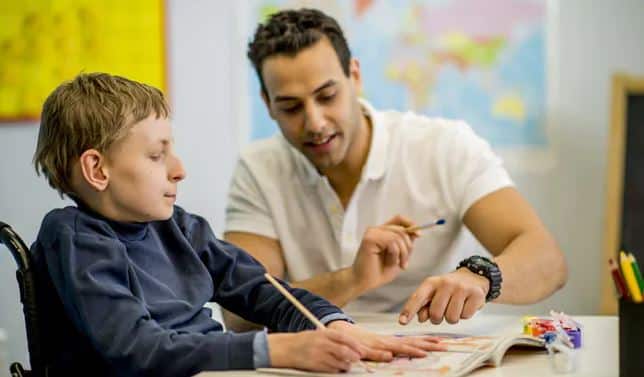Autism spectrum disorder is a condition related to brain development that impacts how a person perceives and socializes with others, causing problems in social interaction and communication.
The disorder also includes limited and repetitive patterns of behavior.
The Diagnostic and Statistical Manual of Mental Disorders (DSM-5), a publication by the American Psychiatric Association (APA) combines forms of the condition, including Asperger syndrome and pervasive developmental disorder not otherwise specified (PDD-NOS) into the diagnosis of autism spectrum disorder (ASD).
An estimated 1% of the population (62.2 million globally) are on the autism spectrum as of 2015.
The cause of the condition is uncertain but it is thought to be associated with genetics and environmental factors.
Autistic patients may be treated with medications used for depression or anxiety due to the stress that may be triggered by being treated as different, but there is no cure for autism as the brain structures affected develop in the womb and cannot be changed.
The autism rights movement promotes the concept of neurodiversity, which views autism as a natural variation of the brain rather than a disorder to be cured.

Causes
Autism spectrum disorder has no single known cause. Given the complexity of the disorder, and the fact that symptoms and severity vary, there are probably many causes. Both genetics and environment may play a role.
- Genetics. Several different genes appear to be involved in autism spectrum disorder. For some children, autism spectrum disorder can be associated with a genetic disorder, such as Rett syndrome or fragile X syndrome. For other children, genetic changes (mutations) may increase the risk of autism spectrum disorder. Still other genes may affect brain development or the way that brain cells communicate, or they may determine the severity of symptoms. Some genetic mutations seem to be inherited, while others occur spontaneously.
- Environmental factors. Researchers are currently exploring whether factors such as viral infections, medications or complications during pregnancy, or air pollutants play a role in triggering autism spectrum disorder.
Autism Spectrum Disorder Symptoms
ASD begins before the age of 3 years and can last throughout a person’s life, although symptoms may improve over time. Some children show ASD symptoms within the first 12 months of life. In others, symptoms may not show up until 24 months or later. Some children with ASD gain new skills and meet developmental milestones, until around 18 to 24 months of age and then they stop gaining new skills, or they lose the skills they once had.
Social Communication and Interaction Skills
Social communication and interaction skills can be challenging for people with ASD.
Examples of social communication and social interaction characteristics related to ASD can include:
- Avoids or does not keep eye contact
- Does not respond to name by 9 months of age
- Does not show facial expressions like happy, sad, angry, and surprised by 9 months of age
- Does not play simple interactive games like pat-a-cake by 12 months of age
- Uses few or no gestures by 12 months of age (e.g., does not wave goodbye)
- Does not share interests with others (e.g., shows you an object that he or she likes by 15 months of age)
- Does not point or look at what you point to by 18 months of age
- Does not notice when others are hurt or sad by 24 months of age
- Does not pretend in play (e.g., does not pretend to “feed” a doll by 30 months of age)
- Shows little interest in peers
- Has trouble understanding other people’s feelings or talking about own feelings at 36 months of age or older
- Does not play games with turn taking by 60 months of age
Restricted or Repetitive Behaviors or Interests
People with ASD have behaviors or interests that can seem unusual. These behaviors or interests set ASD apart from conditions defined by only problems with social communication and interaction.
Examples of restricted or repetitive interests and behaviors related to ASD can include:
- Lines up toys or other objects and gets upset when order is changed
- Repeats words or phrases over and over (i.e., echolalia)
- Plays with toys the same way every time
- Is focused on parts of objects (e.g., wheels)
- Gets upset by minor changes
- Has obsessive interests
- Must follow certain routines
- Flaps hands, rocks body, or spins self in circles
- Has unusual reactions to the way things sound, smell, taste, look, or feel
Other Characteristics
Most people with ASD have other characteristics. These might include:
- Delayed language skills
- Delayed movement skills
- Delayed cognitive or learning skills
- Hyperactive, impulsive, and/or inattentive behavior
- Epilepsy or seizure disorder
- Unusual eating and sleeping habits
- Gastrointestinal issues (e.g., constipation)
- Unusual mood or emotional reactions
- Anxiety, stress, or excessive worry
- Lack of fear or more fear than expected
It is important to note that children with ASD may not have all or any of the behaviors listed as examples here.
Treatment / Management

There is no known cure for autism and the main goals of treatment are to lessen associated deficits and family distress, and to increase quality of life and functional independence.
Types of Treatments
There are many types of treatments available for austsm spectrum disorder. These include:
- applied behavior analysis
- developmental models
- structured teaching
- speech and language therapy
- social skills therapy
- occupational therapy
Applied Behavior Analysis (ABA)
A notable treatment approach for people with ASD is called applied behavior analysis (ABA). ABA has become widely accepted among healthcare professionals and used in many schools and treatment clinics. ABA encourages positive behaviors and discourages negative behaviors to improve a variety of skills. The child’s progress is tracked and measured.
There are different types of ABA. Here are some examples:
Discrete Trial Training (DTT)
DTT is a style of teaching that uses a series of trials to teach each step of a desired behavior or response. Lessons are broken down into their simplest parts, and positive reinforcement is used to reward correct answers and behaviors. Incorrect answers are ignored.
Early Intensive Behavioral Intervention (EIBI)
This is a type of ABA for very young children with ASD, usually younger than 5 and often younger than 3. EIBI uses a highly structured teaching approach to build positive behaviors (such as social communication) and reduce unwanted behaviors (such as tantrums, aggression, and self-injury). EIBI takes place in a one-on-one adult-to-child environment under the supervision of a trained professional.
Early Start Denver Model (ESDM)
This is a type of ABA for children with ASD between the ages of 12-48 months. Through ESDM, parents and therapists use play and joint activities to help children advance their social, language, and cognitive skills.
Pivotal Response Training (PRT)
PRT aims to increase a child’s motivation to learn, monitor their own behavior, and initiate communication with others. Positive changes in these behaviors are believed to have widespread effects on other behaviors.
Verbal Behavior Intervention (VBI)
VBI is a type of ABA that focuses on teaching verbal skills.
Developmental Models
This refers to a developmental intervention that focuses on initiation and spontaneity in communication and following the child’s focus of attention and motivations.
Children on the autistic spectrum typically have trouble picking up the emotional states of others so emotions are exaggerated by the adult. These are often accompanied by verbal labeling; e.g., “See how happy I am!”
Other strategies in the developmental social-pragmatic model include:
- Focus on spontaneous social communication within a flexible structure and varied activities
- Using a range of methods such as speech, song and gestures as communication strategies
- Intervention is child-focused in terms of control, turn taking, and reciprocity
- Meaningful activities or events are chosen for their interest and motivation to the child
- A variety of social groupings used to build skills for complex social experiences
Supports such as visual and gesture cues help the child make sense of activities and interactions
Emotional expression and affect sharing are seen as central to the interactive and learning process.
Developmental models put emphasis on developing communication skills within the context of developing relationships and socio-emotional growth, whereas the role of emotions in motivation and learning is minimized in behavioral interventions.
Speech Therapy
Speech therapy helps to improve the person’s communication skills. Some people are able to learn verbal communication skills. For others, using gestures or picture boards is more realistic.
Mindfullness
A recent systematic review on adults with autism has provided emerging evidence for decreasing stress, anxiety, ruminating thoughts, anger, and aggression through mindfulness-based interventions for improving mental health.
More: Can mindfulness change your brain?
Medication
There is some emerging data that show positive effects of risperidone on restricted and repetitive behaviors (i.e., stimming; e.g., flapping, twisting, complex whole-body movements), but due to the small sample size of these studies and the concerns about its side effects, antipsychotics are not recommended as primary treatment of RRBs.


